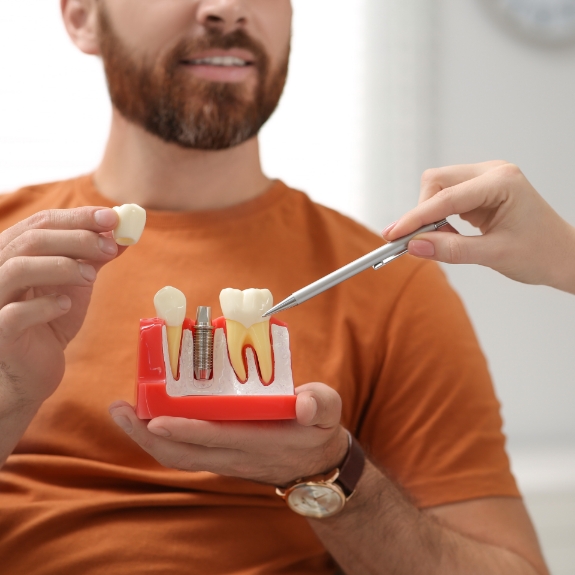
Expert dental tips, news, and smile advice

Expert dental tips, news, and smile advice

Sam didn’t plan on losing his left premolar. One minute he was savoring brisket at a backyard cookout; the next, a loud crack and a wave of dull pain told him the tooth that had haunted him since childhood soccer mishaps was finally finished. In our treatment room a day later, he asked a question we hear weekly at Clover Smile Studio in Austin:
“Do I go with a bridge because it’s faster, or do I invest in an implant and be done with it?”
His dilemma is universal. You’re staring at two tooth replacement options that promise to fill the gap—yet they solve the problem in completely different ways. The challenge is deciding which set of trade-offs fits your mouth, wallet, and timeline.
Picture your missing tooth as a vacant lot on a popular street. A dental implant acts like pouring a brand-new concrete footing, then building a little house—root and all—on its own land. By contrast, a fixed bridge borrows the neighbors’ driveways: the two teeth on either side are trimmed down for crowns that hold a suspended “pontic” (false tooth) between them. Both fill the visual gap; the philosophies underneath are worlds apart.
Sam loved the idea of independence—an implant that wouldn’t lean on adjacent teeth—but he also flinched at the three-to-four-month healing arc when summer adventures beckoned. The bridge tempted him with speed: we could prep teeth on Monday and seat the finished piece before his next paycheck cleared.
So which path wins? Let’s peel back the layers in everyday language.

Early Days
Implant surgery surprises most patients: local anesthesia, gentle placement, and you walk out clutching an ice pack—sore, but not incapacitated. For Sam that would mean two days of Netflix and soft tacos before boredom, not pain, drove him off the couch.
Bridge prep, meanwhile, feels more like an extended crown appointment. Your gums may grumble a bit where they were retracted for impressions, and the temp can feel slightly bulkier—think a pebble in the shoe until you adapt.
Months and Years
Sam’s biggest worry was maintenance. With a bridge, flossing requires a little threader to snake under the pontic; skip it, and plaque parties where you can’t see. An implant, once integrated, behaves like a stand-alone tooth: brush, floss, repeat. Yet implants ask for patience: three to four months of bone-to-titanium fusion (a process we call osseointegration) before the final crown.

Chewing does more than pulverize nachos; it signals your jawbone to stay robust. Remove a natural root and the bone slowly retreats, reshaping your face in subtle ways over the years. The titanium post of an implant keeps that stimulation alive, preserving bone height and width. Bridges, because they hover above the gum, can’t offer that workout. Over a decade, Sam’s jaw might thin enough that a future implant—or even a denture clasp—would need grafting.

Sam’s insurance would pay almost half the cost of a bridge but only the crown portion of an implant, leaving surgery out-of-pocket. On paper, the bridge looked friendly. Yet bridges typically last seven to ten years before decay or wear demands a remake. Factor in possible root canals on crowned teeth and the sum often covertly eclipses the one-time implant fee.
He did the math like this:
Sam’s aha-moment came when he realized the implant cost equaled two smartphone upgrades spread over twenty years. Perspective reshaped the “expensive” label into “long-term value.”

Cosmetics matter—because confidence matters. An implant emerges from the gum like a natural tooth; light hits it believably in selfies. Bridges can look fantastic too, yet the gum beneath the pontic sometimes dips over time, creating a tiny shadow gap. Sam’s social-media-savvy side voted for the chameleon effect of an implant.

Whenever someone sits where Sam did, we run through three touchstones:
If two out of three favor the implant, that’s usually the better call. But sometimes speed or existing crown needs tilt the scales toward a bridge, and that’s perfectly valid.

Sam chose the implant. He scheduled surgery right after finals, binged docuseries with an ice pack, and by autumn, when campus life kicked up, his permanent crown was locked in. One year later, he confided that he no longer thought about that tooth—“It’s just… my tooth.” And that’s perhaps the highest praise any dental work can earn.
So, is an implant better than a bridge?
Usually, yes: an implant keeps your jawbone strong and tends to last decades, while a bridge fills the space faster but may compromise the neighboring teeth and need replacement in 7–10 years.
Discover the best solution for your smile at Clover Smile Studio. Schedule your appointment now and let our expert team guide you to a confident, healthy smile.

Will an implant set off airport metal detectors?
Unlikely. The titanium post sits deep in bone and is too small to trigger modern scanners. At our practice, only one traveler has reported a handheld wand double-checking their dental implant—and even then, a quick explanation sufficed.
What if I’m afraid of surgery?
We offer nitrous oxide, oral sedation, or both, so you’re relaxed yet still safe to head home after a brief rest. Patients often tell us the anticipation was worse than the actual sensation; most resume normal routines (minus strenuous workouts) within 48 hours.
Can a bridge be upgraded to an implant later?
Yes, but remember that the bone may shrink under the pontic. If the bridge fails years down the line, you may need a bone graft to rebuild enough volume for an implant post. Planning for grafting adds both expense and healing time.
Do implants ever fail?
Success rates hover around 95 % when placed in healthy bone and maintained with good hygiene. Factors like uncontrolled diabetes, heavy smoking, or ignoring follow-up visits can lower that percentage. We schedule check-ups at four weeks, four months, and then alongside your routine cleanings to catch any red flags early.
Could a bridge limit what you chew at snack time?
A little. Gooey candies and hard nuts can chip or loosen the porcelain on a bridge more easily than they would an implant crown, because the pressure hits the bridge in a different way. We’ll point out the safer “bite zones” so you can still enjoy those Texas pecans without stressing your new tooth.

Choosing between a bridge and an implant isn’t about right versus wrong; it’s about fit. Think biology, budget, and how you want to feel looking in the mirror ten summers from now. If the implant’s timeline suits your life, the long-game benefits often eclipse the wait. But if urgent aesthetics or existing crown work rule the day, a thoughtfully designed bridge still restores chewing power and confidence.
Ready to weigh your own variables? Our team at Clover Smile Studio is happy to map your bone, run insurance estimates, and talk through real-world scenarios. Call us today or click here to book a consultation—no pressure, just clarity.
Hear from some of our amazing customers who are building faster.

Fill out the form and a member of our team will get back to you with your appointment confirmation shortly!